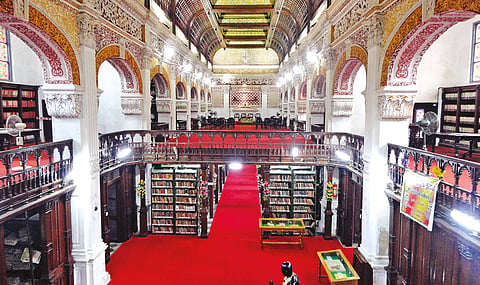

CHENNAI: Libraries have been the traditional corpuses of the knowledge in cities.
The emergence of Google has minimised the importance of libraries. But libraries are the ones that, who have held onto the information without being lost till they were transferred to another technologically superior medium.
The history of the libraries in a town often reveals to an inquisitive mind the knowledge-based culture of that milieu. Chennai (then Madras) has many libraries all of which it needs to be proud of. But glittering amongst them as a crown in the jewel is the Connemara library.
After Mysore, under the fearsome Tipu was defeated, the British inside the claustrophobic fort decided to move out. Egmore- a peninsula surrounded by three arms of the Cooum was a pleasant place to live in and so they built their garden houses. Even for those not living there, the entertainment hub moved there. Assembly rooms, called the Pantheon allowed the Britishers to spend their time in leisure here. The Pantheon complex was huge where then museum and even the zoo was started.
Meanwhile, there was a college in England at Haileybury, which was used primarily to train civil servants for India. The East India company had long ceased to be a textile trader and had got into revenue farming. Post mutiny in 1857 they realised the company could not handle such a large territory and it was handed over to the British empire. The need for civil servants hence increased to enable the empire to govern vast areas.
Haileybury college had an expansive library and at one point they ran out of shelf space. Some of India related books were sent to Madras. But by then the Fort St George library was also in Egmore because of its crowded nature. Hence, the new books formed the nucleus of this individual museum library. In 1861, there were at a point in time, three libraries functioning out of the Pantheon- the museum library, the fort library and the Madras literary society. Till 1890, however, though tens of thousands visited the museum and the zoo very few walked into the library.
Then was felt the need that a growing city like Madras, needed a public library proportional to its dreams. Lord Connemara, the governor decided that a well-designed building holding valuable reading material was the need of the hour.
Lord Connemara’s life can often be compared to a snake and ladder game. Having one’s father-in-law as a former viceroy of India certainly helps in the upward mobility of a political career. Robert Bourke had married Dalhousie’s daughter Susan and was rewarded with the plum post of the Madras governorship which he assumed under his title of Lord Connemara.
He was an excellent governor, who was first at the site of any famine. And his farsightedness in railway expansion in southern India to drainage systems for black town were far reaching.
He also decided a public library was the need of the hour for a presidency and on March 22, 1890 he laid the foundation for it within the Pantheon complex. Lord Connemara also hoped he would be able to inaugurate it when completed. But unfortunately his wife Susan returned from a holiday in the hills a day sooner than expected. She found to her shock the governor’s palace in a state of scandal and the governor in the center of it. She walked out and that ended Robert’s career as well.
One should not be fooled by the drab exterior of the library today. It looks like a non-descript government office. What it was originally was an Indo-Saracenic masterpiece. Irwin had designed the palace of the Mysore Maharajah. In Madras, he had completed Harding’s initial plan for the Central Station. But of all the schemes he had drawn, he seems to have loved this library plan the utmost. For he did an exact replica of it on the beach road for the Bank of Madras ( now State bank).
Namberumal Chetty, the builder of this library, had a series of his own brick kilns in choolaimedu. He would transport it using shallow boats on the cooum. Very rarely has the shallow Cooum been used for boating and this was one. It was six years for the library to be completed. Connemara was by then leading an obscure life somewhere in England, but he was remembered for the idea of a public library and the building was named after him.
The library continued to be a part of the museum till 1939 and then became autonomous. Then began the phenomenal growth. A copy of every book printed in India has to be deposited here. There are 6,00,000 books, periodicals and maps in the library now. That proved the undoing of the old building. A monstrous concrete structure now fronts the library. Irwin’s beautiful library cannot be seen by anybody except on special visits on World Book day.
— The writer is a historian and an author
Visit news.dtnext.in to explore our interactive epaper!
Download the DT Next app for more exciting features!
Click here for iOS
Click here for Android